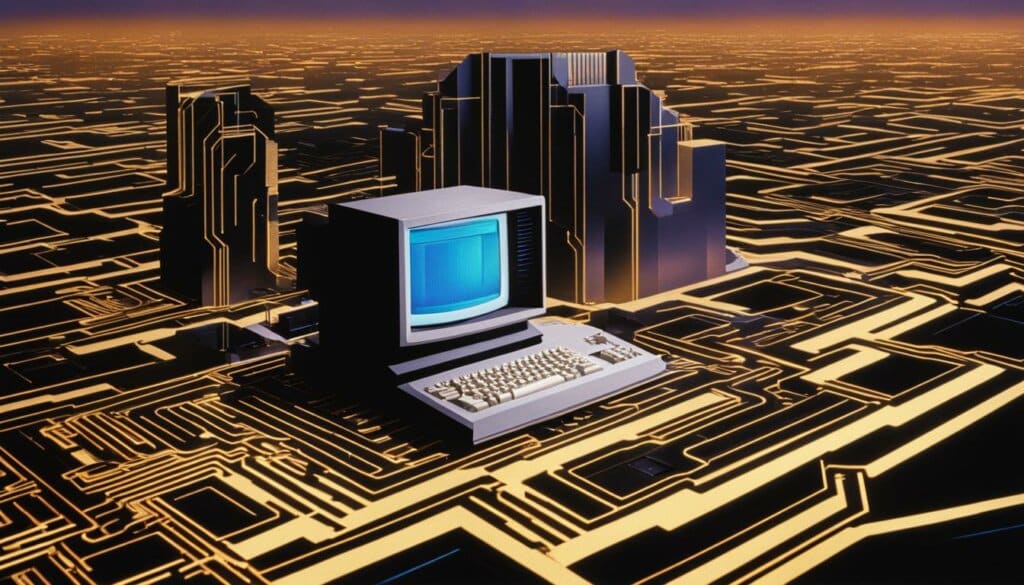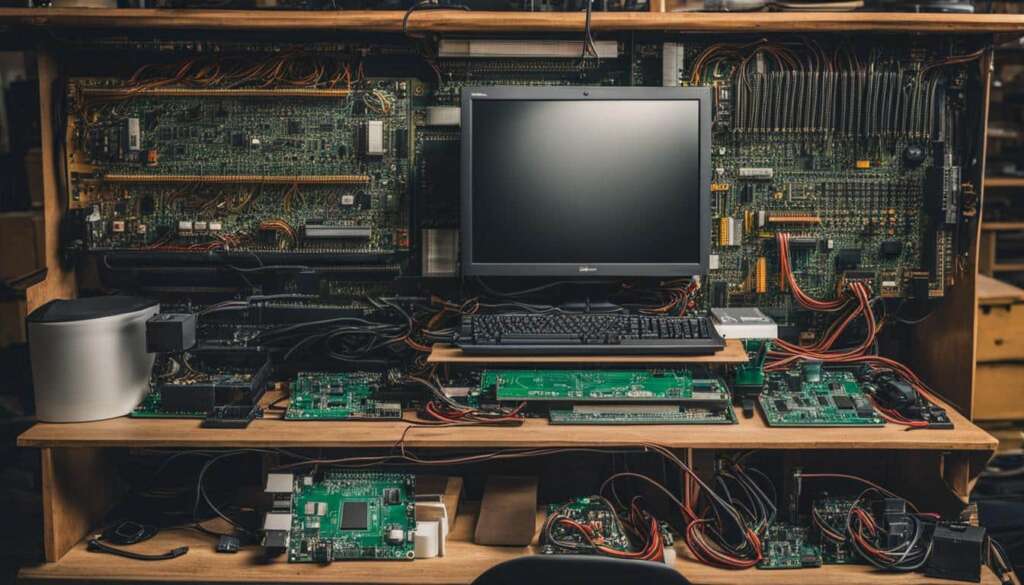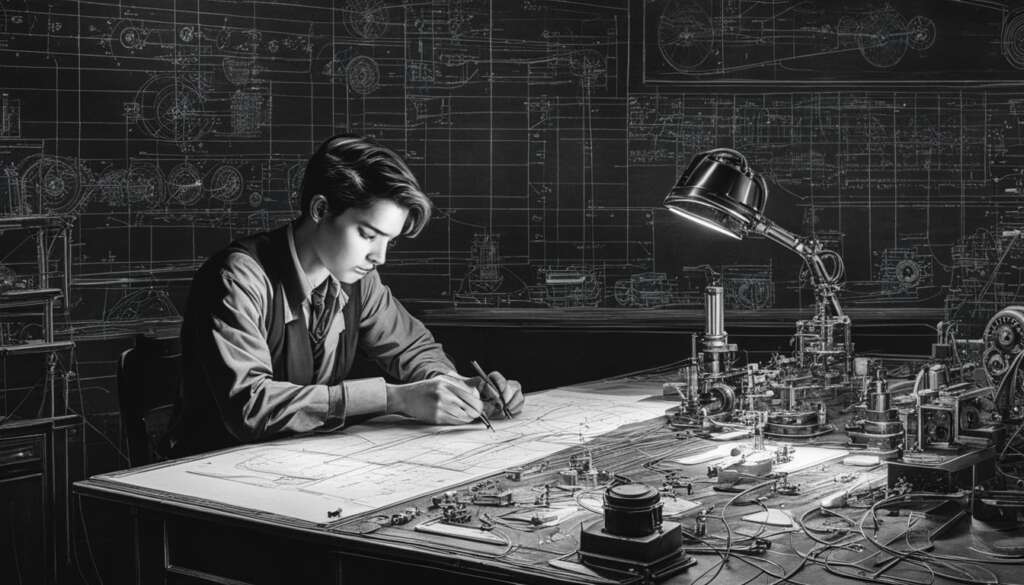Table of Contents
The history of personal computers is a fascinating tale that spans over two centuries. It is a story of technological advancements, innovation, and the computer revolution that has transformed the world. From the humble beginnings of mechanical calculating machines in the 19th century to the powerful and portable devices of today, the evolution of personal computers has shaped the way we live, work, and communicate.
Early personal computers, such as Charles Babbage’s Analytical Engine, laid the foundation for what was to come. These early machines, although large and inaccessible to most, set the stage for the future possibilities of computing. The 1970s marked a crucial turning point with the introduction of more affordable and accessible personal computers like the IBM PC and Apple II. These machines, although primitive compared to today’s standards, opened up new possibilities for individuals and businesses.
In the following decades, personal computers became more versatile and user-friendly. The introduction of the internet in the 1990s revolutionized the way we interacted with computers, opening up a world of information and connectivity. The early 2000s saw the rise of laptops and tablets, making personal computers even more portable and convenient. Today, personal computers continue to evolve, with new technologies like virtual reality and artificial intelligence shaping their future.
Throughout its history, the personal computer has become an integral part of our lives, driving progress in various fields. Whether it’s in business, education, communication, or gaming, personal computers have had a profound impact on society. They have revolutionized the way we work, learn, and connect with others.
In this article, we will delve into the fascinating journey of personal computers, exploring the early developments, the rise of these machines in the 20th century, their impact on society, and what the future holds for this incredible technology. Join us as we explore the history of personal computers, tracing the steps that led to the technological marvels we have today.
Early Developments in Computing
In the 19th century, computers were large and complex machines developed by mathematicians and inventors. These early computers laid the foundation for the technological advancements that would shape the future of computing.
One of the most notable pioneers in this era was Charles Babbage, an English mathematician. Babbage designed the Analytical Engine, a steam-driven calculating machine that could compute tables of numbers. Although his invention was never fully realized, it represented a significant leap forward in computing capabilities.
“The Analytical Engine has no pretensions to originate anything. It can do whatever we know how to order it to perform.” – Charles Babbage
Another key figure in the early development of computing was Ada Lovelace, an English mathematician. Lovelace is often credited with writing the world’s first computer program for Babbage’s Analytical Engine. Her visionary insights into the potential of computers went beyond mere calculations, as she foresaw that these machines could be used to create music, produce graphics, and even simulate human thought.
Ada Lovelace’s Contribution to Computing
| Contributions | Impact |
|---|---|
| Wrote the first computer program | Opened new possibilities for the use of computers |
| Envisioned the potential of computers beyond calculations | Paved the way for future innovations in computing |
These early developments in the 19th century laid the groundwork for the future of computing. Babbage’s Analytical Engine and Lovelace’s programming insights set the stage for the incredible advancements that would come in the following decades.
The Rise of Personal Computers in the 20th Century
In the early 20th century, significant advancements in computing technology shaped the rise of personal computers. This era saw the development of punch-card systems, which revolutionized automated calculations and data storage. These systems allowed for efficient and accurate processing of information, laying the foundation for future technological breakthroughs.
One of the most pivotal inventions of this time was the transistor, which was introduced in 1947. The transistor replaced bulky vacuum tubes used in early computers and paved the way for the creation of smaller, faster, and more efficient machines. The transistor technology brought computing power to a whole new level, enabling the development of personal computers.
Two prominent companies, IBM and Apple, played crucial roles in the rise of personal computing. IBM, a well-established player in the computer industry, released their first mainframe computer in 1952. This marked a significant step forward in computer technology, further driving the evolution of personal computers.
Apple, on the other hand, brought personal computing to the masses with the release of the Apple II in 1977. This groundbreaking machine was one of the first mass-produced computers that featured a user-friendly interface, making it accessible to a wider audience. Apple continued to innovate with the introduction of the Macintosh in 1984, which brought a more visually appealing and intuitive interface to personal computers.
The development of operating systems also played a crucial role in making personal computers more user-friendly and accessible. The introduction of Windows by Microsoft and the Macintosh operating system by Apple revolutionized the way people interacted with computers. These graphical user interfaces made personal computers more intuitive and simplified tasks, opening up new possibilities for users.

With these advancements, personal computers became more than just tools for professionals; they became integral parts of homes, businesses, and institutions. The rise of personal computers in the 20th century laid the foundation for the digital revolution we experience today, where computing power and connectivity play a vital role in our daily lives.
The Impact of Personal Computers on Society
Personal computers have had a profound impact on society in various aspects. The introduction of the internet revolutionized communication and made it possible to connect with people worldwide. Businesses started using computers for tasks such as accounting, data analysis, and communication. Personal computers also transformed education by providing access to online resources and interactive learning tools. Gaming became more accessible and popular with the rise of personal computers. The widespread use of personal computers has transformed the way people work, learn, and interact with each other.
Gaming and Entertainment
Gaming has become a mainstream form of entertainment, thanks to personal computers. The ability to play graphics-intensive games with immersive experiences has been a significant driver in the popularity of personal computers. Online gaming communities and platforms have also emerged, allowing gamers to connect and compete with players from around the world.
Communication and Connectivity
The internet, made accessible through personal computers, has revolutionized communication. Email, instant messaging, and video calls have transformed the way people connect with friends, family, and colleagues. Social media platforms have also gained prominence, providing a space for individuals to share experiences, opinions, and connect with like-minded individuals.
Business and Work
The integration of personal computers into business processes has streamlined operations and improved efficiency. Computers are now essential tools for tasks such as accounting, data analysis, project management, and communication. The internet has enabled businesses to reach a global audience, expanding markets and opportunities.
Education and Learning
Personal computers have revolutionized education by providing access to vast amounts of information and interactive learning tools. Students can now access online resources, e-books, and educational videos that enhance their learning experience. Virtual classrooms and online courses have also become increasingly popular, offering flexible learning opportunities.
| Aspect | Impact |
|---|---|
| Communication | The internet enables instant communication via email, messaging platforms, and video calls, connecting individuals globally. |
| Business | Computers are integral to business operations, improving efficiency in tasks such as accounting, data analysis, and communication. |
| Education | Personal computers provide access to vast educational resources and interactive learning tools, transforming traditional learning methods. |
| Gaming | Personal computers have made gaming more accessible, allowing for immersive experiences and fostering online gaming communities. |
Conclusion
The personal computer evolution has been a remarkable journey, shaped by continuous technological advancements. From the early days of large and expensive machines, personal computers have undergone significant transformations, making them sleek, affordable, and accessible to a wider population today.
The future of personal computers holds great promise, with emerging technologies like virtual reality, artificial intelligence, and the Internet of Things poised to revolutionize the way we interact with these devices. As these innovations continue to evolve, personal computers will become even more powerful, versatile, and indispensable in meeting the needs of individuals and businesses alike.
With the increasing integration of advanced technologies, personal computers will not only enhance productivity and efficiency but also enable new opportunities for communication, automation, and creative expression. As the personal computer landscape continues to evolve, it will undoubtedly shape the future of human-machine interaction and drive innovation in various industries.
FAQ
What was the first personal computer?
The first personal computer was the Altair 8800, introduced in 1975.
When were personal computers developed?
Personal computers were developed in the 1970s.
What were the early personal computers primarily used for?
Early personal computers were primarily used for word processing and basic data analysis.
How did personal computers evolve in the 1980s?
Personal computers became more versatile in the 1980s, with the introduction of machines like the IBM PC and Apple II.
How did the internet revolutionize personal computer usage?
The introduction of the internet in the 1990s revolutionized personal computer usage by enabling global communication and access to information.
How have personal computers impacted education?
Personal computers have transformed education by providing access to online resources and interactive learning tools.
What impact have personal computers had on business?
Personal computers have been widely used in business for tasks such as accounting, data analysis, and communication.
What advancements have shaped the development of personal computers?
Advancements in technology, such as virtual reality and artificial intelligence, have shaped the development of personal computers.
What does the future hold for personal computers?
The future of personal computers looks promising, with emerging technologies expected to make them more powerful, versatile, and accessible.







